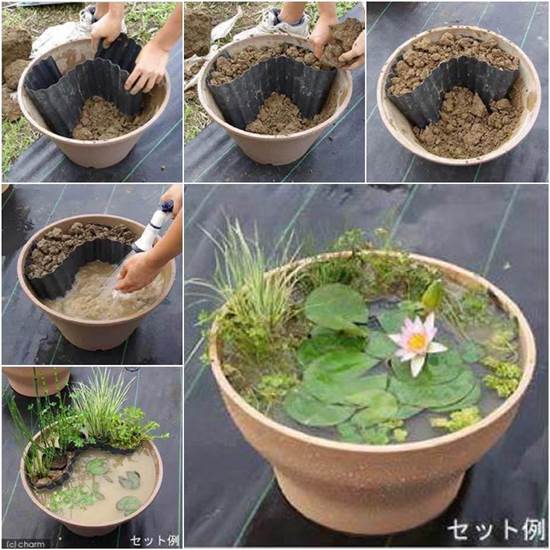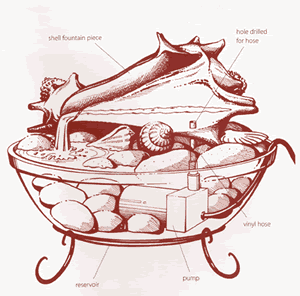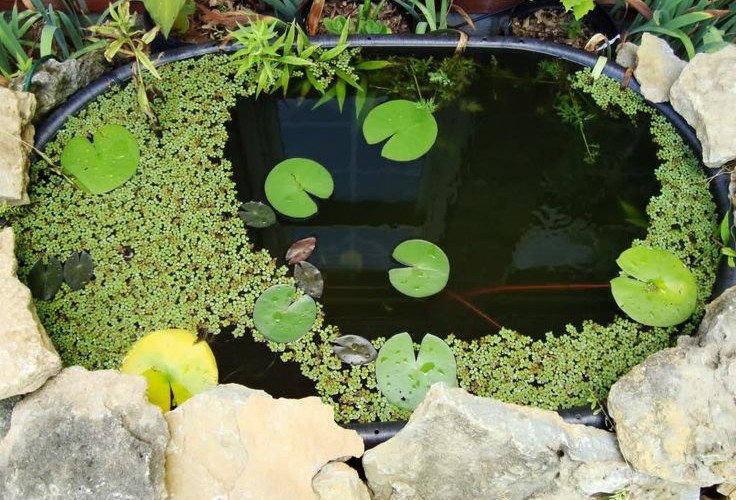
Easy way to make a container pond with plants. Found @ Creative Ideas.
It is said that the first container ponds were designed in Ming Dynasty, China for viewing fancy goldfish as they swim around in wide mouthed ceramic pots. And, although I can’t find an original citation for this statement, I can say it’s a pleasant enough idea that we’ll go with it. After all, ceramic pots aren’t much further from a glass goldfish bowl. And, they can sure make a statement about who and what you are — something that the Ancient Chinese royalty loved to do in the most ostentatious way possible.
We are lucky though. In the modern age we have a much larger selection of sturdy containers that we can use to hold fish and plants that we can add to any garden for a touch of calming water. Whether you lean towards the whimsical or the traditional, upright or rambling spillways, you’ll need to know a few things before you start your container garden designs.
Any large container will do
Before we get too far into dreaming, we need to take a look at our foundation: The container itself. While any container will do, there are a few things to take into consideration for an outdoor pond. And guess what? They are very much the same factors you would think about when choosing any container for the garden: size, material, what you plan to use it for, and if you plan to over winter it. Then, there are also the considerations for the fish and plants to keep in mind as well.
Size does matter
For a healthy pond that you don’t have to spend an undo amount of time caring for should be no less than 5 gallons, preferably 7 gallons . This size would enable a few fish to live in a healthy environment even without running water and a biological filter. However, Lambert cautions, that you should go with the minimum number of fish for this type of feature — dead fish are never a pleasant sight.
The exact size and shape of the container depends largely on what you’d like to do with it. A simple pond can be made with a single large pot like above. If you want to get fancier, though, you’ll need to use your imagination and get a handle on water flow, pumps, and filters.
Aeration
 Now, you can increase the number of fish you can keep in a smaller container by providing moving water and a bit of aeration to the system. To do this, you’ll need a pump that can move the amount of water you have. If you want to do anything fancy, such as having the water come out of a spout at the top, then you’d also need a tube to direct the water through the pump and into. This can be as simple as the conch diagram to the left where a short tube feeds the water up through the pump and into the shell.
Now, you can increase the number of fish you can keep in a smaller container by providing moving water and a bit of aeration to the system. To do this, you’ll need a pump that can move the amount of water you have. If you want to do anything fancy, such as having the water come out of a spout at the top, then you’d also need a tube to direct the water through the pump and into. This can be as simple as the conch diagram to the left where a short tube feeds the water up through the pump and into the shell.
Not surprisingly, it can be as complicated as you want as well. Most small fountains are not complicated and a pump with a lower flow rate on it should serve you well. However, when you start adding height and volume, you’ll need to take a closer look at the flow rate.
The flow rate is measured in gallons per hour at ground level. When you add elevation, you’ll need to make sure you have a flow rate that’s a bit higher to accommodate the added height so the water can fight against gravity and come out at a decent velocity. Too much, and the water stream will miss the pool, too little and it will dribble out and down pathetically.
Filters
Most pumps have a small filter on them to keep out some basic muck. However, if you are keeping fish in your pond, you may want to consider getting a biological filter pump from a store that specialises in fish. Walmart, sadly, usually doesn’t have enough variety for outside work, and hardware stores are hit or miss on if they are likely to have biological filters.
Biological filters are rather large, bulky items that are quite ugly to look at. They are graded much the same way pumps are by water flow, so choosing one is largely based on the same principles. The only other information to take into account would be the type of filter. There are different filters for different scenarios. Activated charcoal, for example, is a simple filter that can help filter out bacteria that are carried in the faecal matter, but this type of filter is only really effective in small ponds and must be changed very regularly.
The best advice I can give about filters and pumps is talk to a specialist in the store about your particular vision. You may need a specific type of filter based on the water volume, types of fish, and even the environment you live in. One single blog post will not be sufficient to help you navigate those waters.
Want ideas for your new pond paradise? Check out this Pinterest board full of ideas.
Follow Grace’s board Gardening: Container Ponds on Pinterest.

